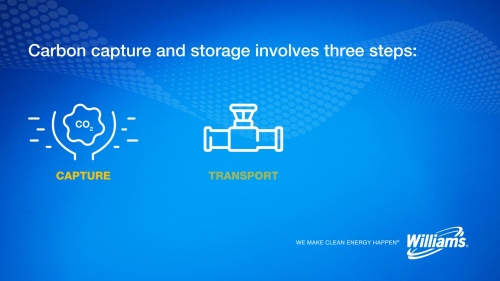Carbon capture, utilization and sequestration are tools to help Williams advance our climate commitment and support the lower carbon economy.
Carbon Capture and Sequestration (CCS) refers to technologies that capture carbon dioxide (CO2) and store it safely underground.
CCUS includes utilization, when the captured CO2 is utilized by another process or product.
What we are already doing
Williams currently captures CO2 at our Dilley treatment facility in Texas for sequestration and Parachute Creek gas processing plant in Colorado for utilization. Engaging in the CCS and CCUS value chain can reduce our operational emissions and support our customers’ emissions reduction goals.

What we are working on
- As part of our Corporate Venture Capital program, we’ve invested in ION Clean Energy, a carbon capture technology firm that has developed tools that Williams and our customers can use to further decarbonize operations. In 2025, we kicked off two different feasibility studies that utilize ION’s capture technology.
- Our Louisiana Energy Gateway expansion project is planned to be in service later this year and will increase our natural gas gathering capacity in Haynesville by 1.8 billion cubic feet a day (Bcf/d), and an accompanying CCS project will later capture and sequester up to an estimated 750,000 tons of CO2 per year.
- Another project along the Gulf Coast is Longleaf CCS hub. We are conducting a front-end engineering and design (FEED) study on one of our compressor stations and on pipeline infrastructure in Alabama as part of the CarbonSAFE grant received in 2024.
- Williams is also breaking ground this year on the Echo Springs CCS project, using funds from CarbonSAFE and a Wyoming Energy Authority grant received in 2024. Wyoming is one of the largest emerging hubs for CO2 pipeline infrastructure and projects in the Western U.S.
Additionally, Williams is a member of the Global Carbon Capture and Storage Institute, an international think tank whose mission is to accelerate the deployment of CCS globally.
According to the Institute, CCS involves three steps – capture, transport and storage, or sequestration.
Capture
During capture, CO2 is separated from other gases produced at large industrial facilities, such as steel mills, cement plants, petrochemical facilities, coal, and gas power plants, or from the atmosphere. There are several capture methods in use – all are proven and effective, with different methods applied based on the emissions source.
Transport
Once separated, the CO2 is compressed for transportation. This means increasing pressure so that the CO2 becomes a liquid. The compressed CO2 is then dehydrated before being sent to the transport system. Pipelines are the most common mode of transport for large quantities of CO2.
Sequestration
Following transport, the CO2 is injected into deep underground rock formations, where it is safely and permanently stored. These rock formations are similar to what has held oil and gas underground for millions of years.
To read more about Williams and carbon capture and storage, see our latest Sustainability Report.
